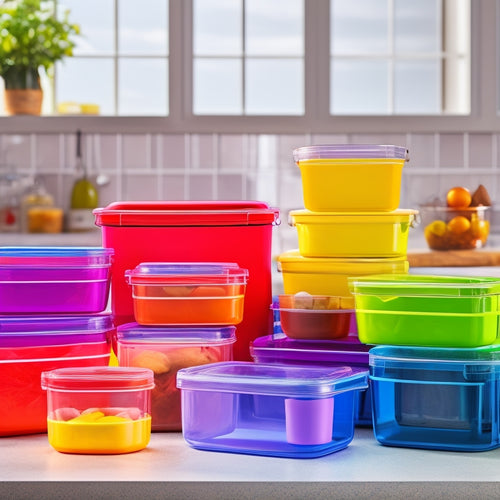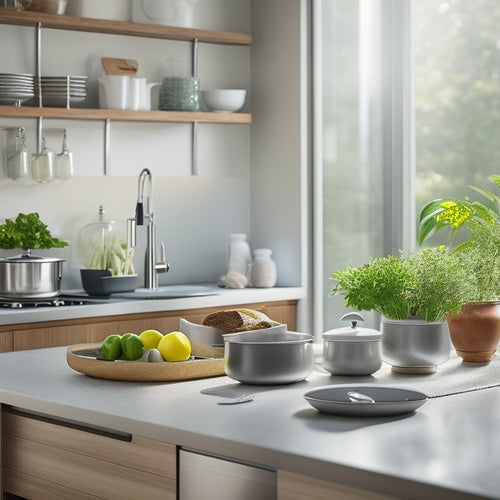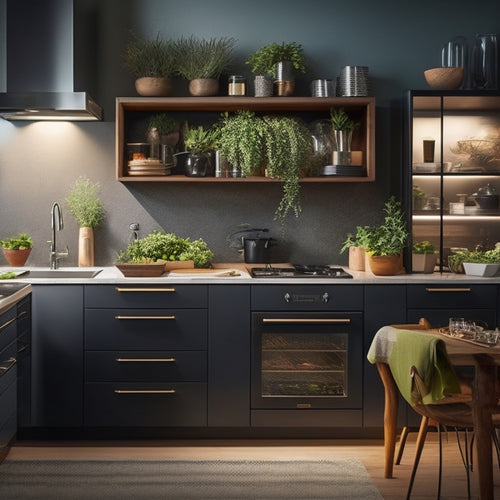
Revolutionizing Food: 3D Printing Unveiled
Share
3D printing is revolutionizing the food industry by enabling the production of complex, customized, and sustainable food products with unprecedented precision and control. This technology allows for tailored nutrition, reduction of waste and storage requirements, and promotion of sustainable manufacturing practices. The possibilities are endless, with opportunities to design bespoke food products, create novel textures and sensations, and bridge the gap between culinary artistry and mass production. As this innovative technology continues to advance, its potential to transform the food industry is vast, with exciting developments waiting to be explored.
Key Takeaways
• 3D printing enables unparalleled customizability in food products, allowing for tailored nutrition and unique flavors.
• This technology promotes sustainable manufacturing practices, reduces waste, and minimizes storage requirements.
• 3D printing guarantees uniformity in mass food production, ensuring consistency in taste, texture, and quality.
• It bridges the gap between culinary artistry and mass production, offering personalized flavors and novel textures.
• 3D printing has the potential to revolutionize the food industry, creating innovative products that cater to diverse tastes and dietary needs.
The Future of Food Production
How will the integration of 3D printing technology in food production revolutionize the way we manufacture, distribute, and consume food, and what implications will this have on the future of the food industry?
The incorporation of 3D printing in food production is poised to transform the industry by providing sustainable solutions and technological advancements.
This innovative approach will enable the creation of customized food products with precise nutritional content, reducing waste and storage requirements.
Moreover, 3D printing will facilitate the production of complex food structures, opening up new possibilities for food texture and design.
As the industry adapts to this technology, we can expect a shift towards more efficient, sustainable, and consumer-centric food production.
How It Works: A Deep Dive
Through a symbiotic marriage of culinary art and advanced technology, 3D printing transforms raw ingredients into intricate, edible structures, defying traditional culinary boundaries.
The printing process begins with material selection, where paste-like or malleable foodstuffs are inserted into the printer canister. The ingredients are then heated to achieve ideal malleability, allowing for precise manipulation during the printing process.
Edible resin is pushed through a syringe-like dispenser, undergoing instantaneous curing, and perishables are fixed in place through chemical reactions. This precise control enables the creation of complex structures and customized shapes, revolutionizing the possibilities of food production.
As the technology continues to evolve, the potential for innovative and safe food products is vast.
Taste, Safety, and Quality Control
The taste of 3D-printed food is largely dependent on the type or flavor of ingredients loaded into the printer, with heat exposure during the printing process having a minimal impact on the final flavor profile.
Texture, however, can be influenced through varying printing techniques, allowing for a range of culinary experiences. Despite these variations, the taste remains unchanged.
To ensure food safety, it is important to print in a clean environment, adhering to regular food-handling and health codes. Sanitized equipment and fresh ingredients are essential, as is following safety protocols for food production.
Advantages of 3D-Printed Cuisine
One of the most significant benefits of 3D-printed cuisine is its unparalleled customizability, allowing for the creation of food products tailored to specific nutritional needs, flavor preferences, and structural requirements. This capability enables personalized nutrition, where individuals can receive food products that cater to their unique dietary needs.
Moreover, 3D printing in food manufacturing promotes sustainable manufacturing practices, reducing waste and storage requirements. The precision of 3D printing also guarantees uniformity in mass food production, eliminating inconsistencies often found in traditional food production methods.
Examples of 3D-Printed Delights
Beyond the conceptual sphere, 3D-printed cuisine has given rise to a diverse array of innovative products, spanning from plant-based seafood alternatives to intricately designed pasta shapes. Culinary creativity has been harnessed, allowing for the development of unique and artistic confections.
For instance, Plantish's vegan salmon filets and RevoFoods' smoked salmon offer sustainable seafood alternatives. Barilla's BluRhapsody has introduced customized 3D-printed pasta shapes, while Sugar Labs and CandyFab Project have created intricate sugar sculptures.
These examples demonstrate the vast potential of 3D printing in revolutionizing the food industry. With precision and control, 3D printing enables the creation of complex designs, textures, and flavors, pushing the boundaries of culinary innovation and artistic expression.
Customization and Innovation Opportunities
Customization capabilities inherent to 3D printing technology enable the creation of personalized food products that cater to individual tastes, dietary needs, and nutritional requirements. This innovation opens up a world of possibilities for culinary creativity, allowing consumers to experience personalized flavors tailored to their unique preferences.
Technological advancements in 3D printing have bridged the gap between culinary artistry and mass production, making it possible to:
-
Design bespoke food products with intricate structures and flavors, elevating the dining experience.
-
Create nutrigenomically tailored meals, ensuring best nutrition for individuals with specific dietary needs.
-
Develop novel food textures and sensations, pushing the boundaries of culinary innovation.
The Impact on the Food Industry
The advent of 3D-printed food is poised to revolutionize the food industry, transforming the way companies design, manufacture, and distribute their products.
This innovation is expected to cause market disruption, driving industry evolution as traditional manufacturing processes are replaced by additive manufacturing.
The integration of technology into culinary practices will bring about a culinary transformation, enabling the creation of complex shapes, customized nutrition, and reduced waste.
As 3D printing technology advances, food companies will need to adapt to stay competitive, leading to a significant shift in the industry's landscape.
With the potential to increase efficiency, reduce costs, and enhance product quality, 3D-printed food is set to revolutionize the way we produce and consume food, paving the way for a safer, more sustainable, and personalized food industry.
Frequently Asked Questions
Can 3d-Printed Food Be Stored and Refrigerated Like Traditional Food?
When stored and refrigerated properly, 3D-printed food maintains its taste and texture, ensuring food safety and preservation, as long as sanitized equipment, fresh ingredients, and adherence to health codes are upheld.
Are 3d-Printed Food Products More Expensive Than Traditional Options?
In the world of culinary innovation, the million-dollar question arises: do 3D-printed food products break the bank? Cost comparison reveals a nuanced answer, as premium taste preferences and novel textures may justify higher prices, but economies of scale and mass production could ultimately offset costs.
Can I Purchase a 3D Food Printer for Personal Use at Home?
For personal home use, 3D food printers are available, but affordability varies widely. Maintenance requirements and customization options should be considered. Safety-focused consumers should prioritize sanitizable designs and user-friendly interfaces when selecting a printer for home use.
Are There Any Limitations to the Types of Food That Can Be 3D Printed?
As the gates of culinary innovation open, limitations arise: 3D printing faces hurdles with high-moisture, high-fat, or fragile ingredients, raising health concerns and cultural implications, while sustainability and customization options remain key drivers in this evolving landscape.
Will 3d-Printed Food Replace Traditional Cooking Methods in the Future?
While 3D-printed food may augment traditional cooking methods, it is unlikely to replace them entirely, as food safety and taste concerns, along with environmental impact and accessibility considerations, will continue to shape the culinary landscape.
Related Posts
-

Stackable Kitchen Containers for Modular Systems
Stackable kitchen containers for modular systems change your cooking space by maximizing vertical storage and enhanci...
-

Dish Drainer Options for Kitchen Islands
When selecting dish drainers for your kitchen island, consider options that maximize space and enhance workflow. Comp...
-

Smart Kitchen Countertop Storage Innovations
Smart kitchen countertop storage innovations are transformative for maximizing your kitchen's potential. You can clea...


